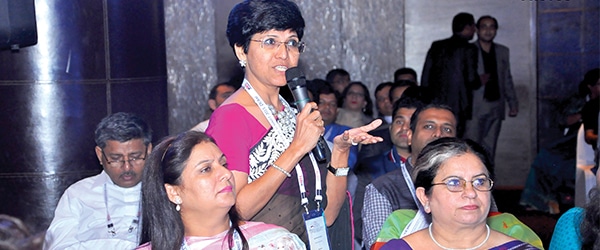
New Trends & Technology in Schools
Access to information ‘anytime, anywhere’ is soon gaining momentum and ensuring that the learning sector in India earns this de ning mantra for educational digital learning solution providers. The traditional classroom teaching model is slowly metamorphosed into digital education learning platform, turning into a self-driven, ‘eduprenuerial’ and fast industry, writes Jessy Iype of Elets News Network (ENN)
Gone are the days when students and teachers had the access to just blackboard classroom teaching. The new wave of digitisation has reaped in a plethora of technological solutions to help ease out not only the learning aspect but making school a platform for holistic development of the children through knowledge of their activities as well.
Pupils nowadays are well-versed with Play Stations and iPads, via digital learning, and are making smart classroom environment more inclusive and participatory, thus transforming the education system into an IT-enabled education system. However, resistance to change along with certain infrastructure challenges is hindering the growth market India’s online education market, which is poised to reach $40 billion by 2017.
The Market Scope
Online learning or Live Virtual Classrooms (LVC) has opened new career avenues for young professionals who are driven to imbibe new skills – at the luxury and comfort of their own place and time.
Ganesh S, Business Development Manager, DLP Products Texas Instruments (I) Pvt Ltd says, “Our product has millions of particle mirrors in classroom, DLP chip gets used in classroom projectors. This is nice chart on how technology is spent well globally. 50 billion of hardwares were purchased for classrooms globally, out of which 5 million classroom displays were purchased. 60 percent north American schools had interactive display. Asia has 18 million classrooms which have interactive display – anyone who has interactive display is using multimedia source for learning.”
On how to use the innovative solutions effectively pan India, Ganesh said, “Broadly split this into how it has reaped in government and private schools. In government ones, there is use of ICT labs, scanner among others. There is a greater marriage between how a teacher can use innovations with students effectively. Engagement of students is far high in such classes. Lot of interactivity features are seen, like whitewall into interactive service, trying to make optical engine into ultra shot one, where no light falls on the teacher. This can help penetration in areas where there’s no power, transportable devices. All optical engines are hundred per cent sealed and not have filters and helps in total cost of ownership.”
Panacea to Tracking Child Activities

Country Head (Solution Division), Tech Smart Solutions on new technological trends in school at the WES 2015
With the evolution of technologies such as the Cloud, Data Centers & Virtualisation, the digital education ecosystem that we forsee is not a distant reality. There is a growing affinity by Indian youth for new technologies and products such as tablets, notebooks, LMS and IWB, educational institutes, and schools as there is a huge potential for technology to be integrated into education industry. Trickling down to the K12 segment, number of rural schools and teachers are embracing the ‘self-learning’ teaching models, serving as a significant communication bridge between students and teachers.
“It is important to understand how much we can do, certain cross checks, at right place and time to avoid multiple duplication of backups,” says Gaurav Singh, Country Head (Solution Division), Tech Smart Solutions.
Talking about the company’s motto to ensure a holistic development for the child and provide a panacea for parent worries, Singh states, “In last three years, we have realised the need to incorporate technology for small children also as parents are unaware of children’s activities in school and their safety. We provide world leading technology solutions for security where parents can track their child in bus and schools, their daily activities whereabouts – empowered as parents, and this ensures progress of the child.”
Schools nowadays offer smart solutions like Cashless facility called e-wallet as per the requirement or have Wi-Fi zones around the campus, says Singh.
The digital platforms, by a huge margin, strategically deals with the less innovative pedagogy styles and lack of teachers for specialised subjects – giving students the best e-learning experience and seeding an element of independency in their learning style.
“Now schools have smart solutions, like SOS buttons. In emergencies, students can talk to their near dear ones through telephone booths. Chatting with teachers and parents, assignments, biometric attendance, visitor management, admission management, smart class boards, among many other solutions ensure information of the child at every minute. We are revolutionising the sector through these solutions,” informs Singh.

Security Checks
Apart from having technological solutions in classroom learning, it is also necessary to initiate security in the school campus. With the recent unsafe incidents being brought to light where children are left at the plight of suspicious in nature of guards, it is an eye-opener for us to act and save children from being abused and exploited.
Gautam Goradia, CEO, Com-Sur, opines, “Technology is something that is in our hands to enhance the safety of our educational institution, of people who work there, the safety of children and so on. The philosophy of our technology like in case of video surveillance is not enough. Technology can help let us know about guard list and authencity of personnel in schools. Often if you see if the child is victimised he/she doesn’t realise what is happening to him or her. They complain many days later, maybe evidence or the footage is overwritten and nobody checks.”
“There should be a mandate to have a CCTV, a visual anti-sabotage and many more. We must use technology that is simple and cost effective. And that should have outcomes. Schools need to monitor it daily as a standard operating procedure. Create a back up TV on a cloud or computer, to retain an evidence. There is a need to create standarised format using power point,” added Goradia.
To Show the Way
Digital alternatives like Integrated Digital Interactive Classroom (IDIC), Content Management System (CMS) and Classpad can bring an element of reliability in students – making them more competitive in their respective courses. Against this backdrop, there is a huge potential for educators in India to leverage the missing link between teachers and their students – and bridge the digital divide.
Dr Vandana Lulla, Director, Podar Group of International Schools, Mumbai, says, “When I started my journey 16 years ago, there were only computer contracters in schools, then came interactive boards, smart boards, edupads, tablets, etc. It has come a long way. But there is much more to come. However, the question to be asked is, are we preparing our students for 21st century and on collaborating skills?”
Green technology that sustains the environment should be used is what Virendra Rawat, Principal, B-Kanae School, Modasa, feels. “Not only using technology, but we should use environmental technology, we use green technology, and we use tablet to collaborate learning,” he adds.
Lulla further says, “The kind of skills that are developing in today’s classrooms should focus on latest trends in developing creativity. Even though children have leaped into the 21st century, teachers are still in the 19th century and the school infrastructure are in the 15th century. Schools need to push them and management needs to be pulled up. Blogs are a good way to have parents contribute. The outcome would be a wonderful discussion and flip classrooms.”
Sadhna Pandey, Principal, The Millenium School, Nagpur, says, “Teacher training should be an ongoing process and regular updation of curriculum should be done. Cloud computing is a good way to store the matter and research on the internet, constant follow-ups are required, every infrastructure needs to be developed and on developing milestone.”





















